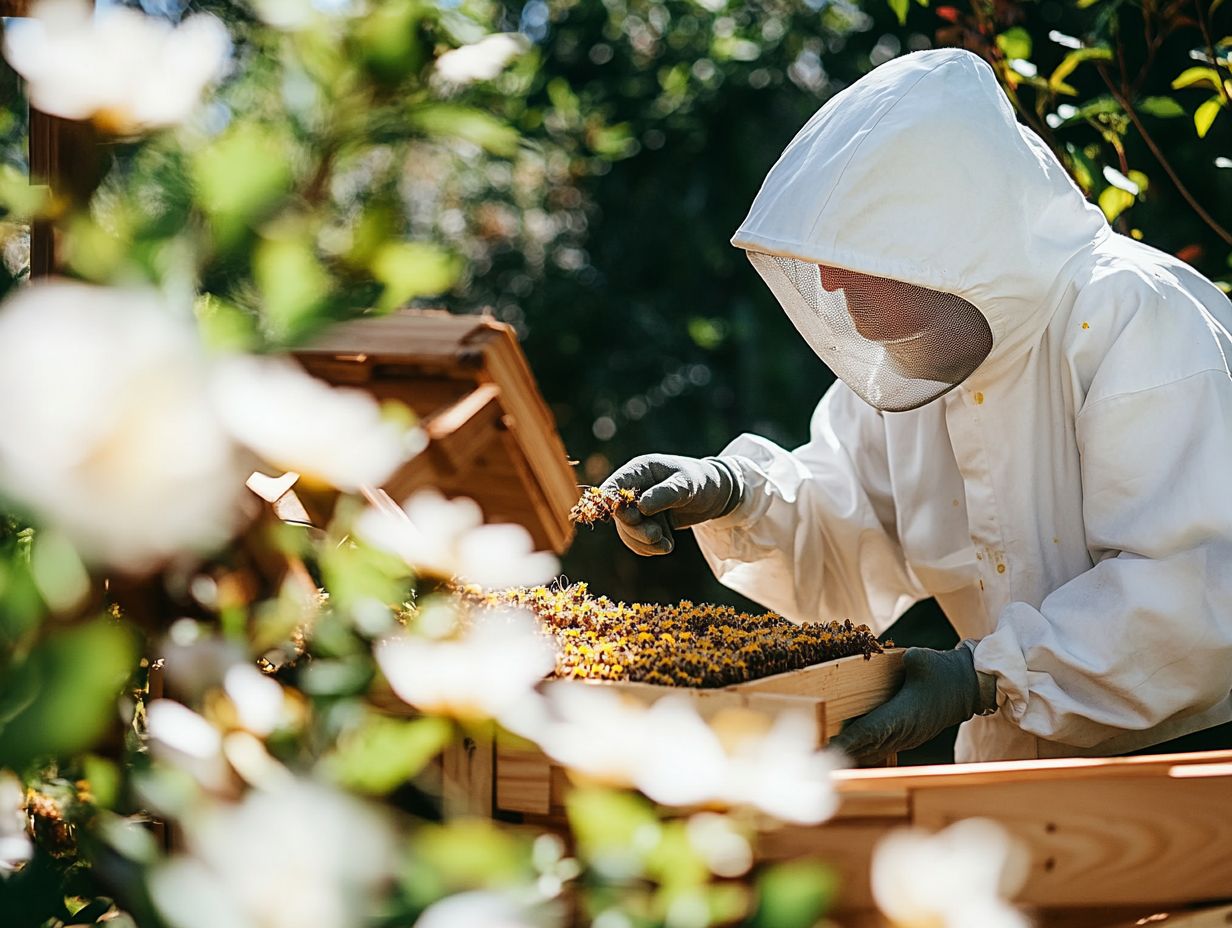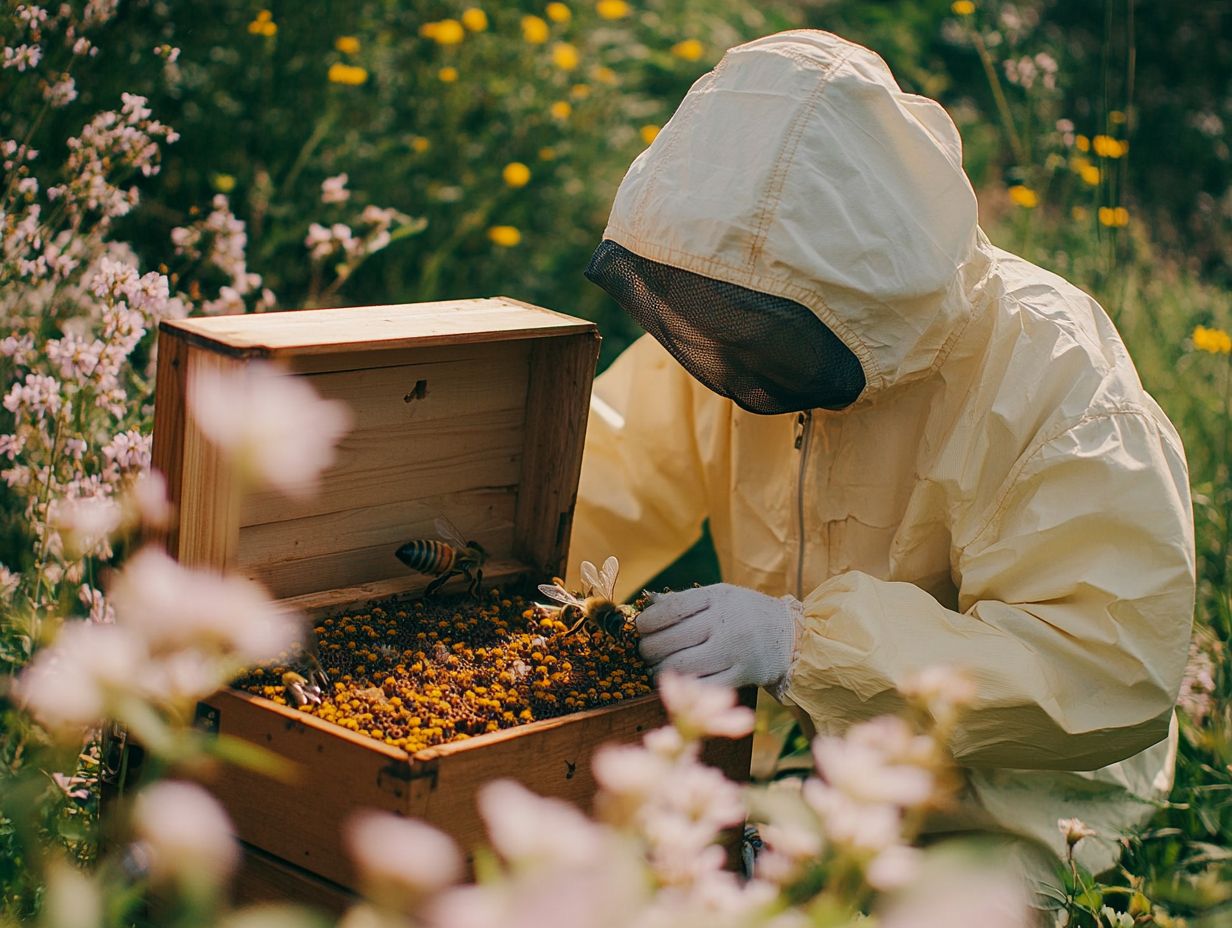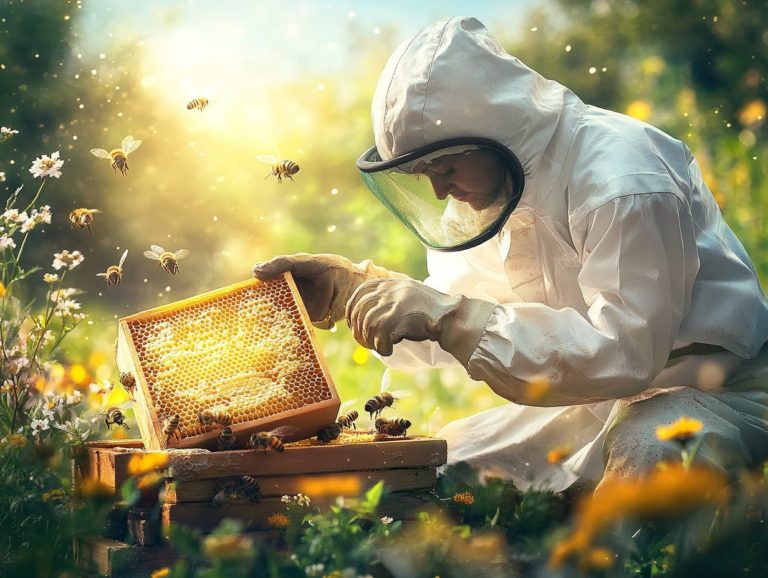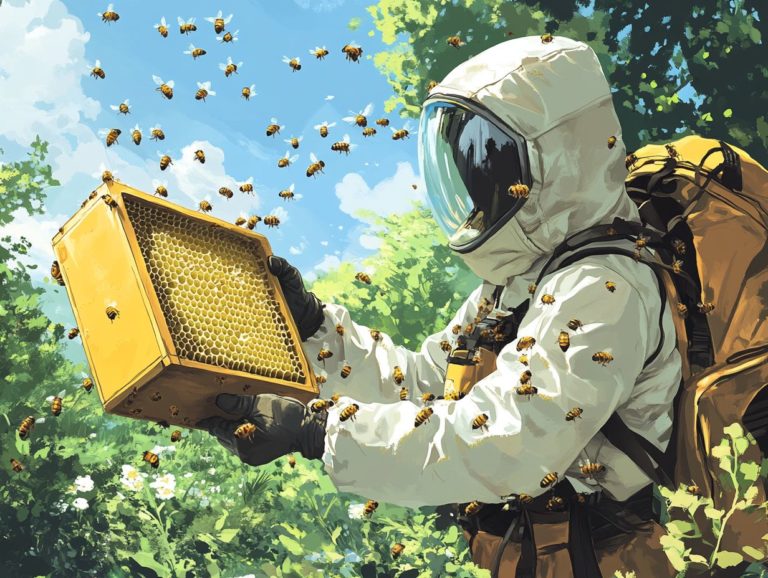How to Use Pheromones in Hive Management
Pheromones hold a vital, yet frequently underestimated position in the intricate realm of beekeeping. These chemical signals serve as the lifeblood of communication among bee colonies and profoundly impact hive management strategies.
By delving into the various types of pheromones and understanding their specific functions, you can significantly enhance the health of your colony, improve queen recognition, and strengthen your bees’ defense mechanisms against potential threats such as predators and environmental factors.
This article will guide you through the myriad ways pheromones can be effectively harnessed in hive management, detailing their advantages, applications, and essential safety considerations for optimal use.
Discover how these natural wonders can transform your beekeeping experience by influencing bee behavior and colony dynamics!
Contents
- Key Takeaways:
- What Are Pheromones?
- How Do Pheromones Play a Role in Hive Management?
- Why Should Beekeepers Use Pheromones in Hive Management?
- How Can Beekeepers Use Pheromones in Hive Management?
- Are There Any Risks or Side Effects of Using Pheromones in Hive Management?
- Frequently Asked Questions
- How do pheromones play a role in hive management?
- What are the different types of pheromones used in hive management?
- How can I use pheromones to prevent swarming in my hive?
- Are there any natural alternatives to using synthetic pheromones in hive management?
- Can pheromones be used to control pests in a hive?
- How often should I use pheromones in my hive management practices?
Key Takeaways:

- Pheromones play a crucial role in hive management by aiding in queen recognition, colony communication, organization, and defense against predators.
- Beekeepers can use pheromones in hive management through various methods and at specific times, such as during the process of replacing an old queen with a new one or during swarming behavior, to maximize their effectiveness.
- While there are potential risks and safety precautions to consider, the benefits of using pheromones in hive management far outweigh any potential drawbacks, especially when considering genetic diversity and reproductive behavior.
What Are Pheromones?
Pheromones are fascinating chemical signals released by bees, serving a vital role in their communication and behavior. These cues greatly influence how bees interact and organize in their colony.
They can evoke a range of responses from nursing duties to foraging (the act of searching for food) and even defensive behaviors creating a complex social structure among the bees. Notably, the queen pheromone is essential for maintaining cohesion within the colony, while brood pheromones aid in brood maintenance and help worker bees recognize one another.
This highlights the intricate and sophisticated nature of chemical communication thriving within bee colonies, involving various pheromonal signals and feedback mechanisms.
How Do Pheromones Play a Role in Hive Management?
Pheromones serve as essential instruments for adept hive management, giving beekeepers the power to refine colony organization and elevate overall hive health. By grasping the diverse pheromonal signals emitted by bees ranging from cues related to queen dynamics to those involving forager bees and nursing states you can implement strategies that foster colony reproduction and alleviate stress among worker bees.
Leveraging both synthetic pheromones and natural signals can enhance your ability to manage supersedure and synchronize hive activities, culminating in healthier and more productive bee colonies with improved genetic diversity.
Have you ever wondered how pheromones affect bee behavior? Dive into the world of pheromones today and see the difference in your hives!
What Are the Different Types of Pheromones Produced by Bees?
Pheromones are natural chemicals that bees produce to communicate. Bees produce a fascinating array of pheromones, each serving a unique and essential function within the colony, integrated into how they communicate and behave. The queen pheromone, for instance, is crucial for maintaining social harmony and signaling her presence to the hive.
Brood pheromones, on the other hand, send a clear message to the worker bees, indicating the need for taking care of the young bees. Alarm pheromones act as the colony’s early warning system, alerting bees to potential threats and triggering defensive responses.
Meanwhile, Nasanov pheromones assist forager bees in locating food sources, illustrating the sophisticated chemical communication network that is vital for the colony’s survival and efficient resource allocation.
These pheromones are important chemical signals; they are carefully crafted mixtures produced by specialized glands within the bees. Take the queen’s pheromone, for example. It comprises several components, including fatty acids and esters, which effectively suppress the reproductive capabilities of worker bees, ensuring that only the queen breeds and manages ovary development.
Brood pheromones are rich with unique chemical markers that guide worker bees in identifying and nurturing the larvae. Alarm pheromones typically consist of volatile compounds that provoke an immediate response, heightening alertness throughout the hive.
Lastly, Nasanov pheromones blend seamlessly with environmental scents, directing foragers to abundant nectar sources and exemplifying the remarkable adaptability and efficiency of hive dynamics, including winter survival mode.
Why Should Beekeepers Use Pheromones in Hive Management?
As a beekeeper, you should consider utilizing the strength of pheromones in your hive management practices. These natural agents offer an effective way to optimize bee behavior, enhance colony dynamics, and elevate overall hive performance and genetic component.
By skillfully leveraging pheromonal signals, you can influence the chemical cues that dictate worker recognition and foraging behavior, ultimately leading to more efficient resource allocation and healthier colonies. This includes better larval feeding and colony nutrition.
You can strategically apply pheromones not only to foster a balanced social structure within the hive but also to significantly boost the productivity and reproductive capabilities of your bee population, leading to successful mating and improved bee lifespan.
What Are the Benefits of Using Pheromones in Hive Management?

The advantages of incorporating pheromones into your hive management strategies are extensive, as they enhance colony organization and elevate the overall health of your bee populations. Pheromones play a crucial role in influencing worker recognition and assigning specific tasks, such as nursing duties and foraging behaviors, which are essential for meeting the colony’s nutritional needs and ensuring its survival through winter. They also help in pheromonal feedback and retinue response.
By strategically applying pheromones, you can foster more effective communication within the hive, promoting collaboration among worker bees and ultimately boosting productivity. For example, SuperBoost can enhance brood rearing and overall hive health.
Research has demonstrated that when beekeepers like you harness the power of pheromones, they can create environments that minimize stress and agitation among bees. This, in turn, results in improved honey production and quality, as detailed in journals like the American Bee Journal.
A compelling case study from Florida revealed that colonies treated with a specific queen pheromone experienced a remarkable 20% increase in brood rearing compared to control groups. This highlights the effectiveness of pheromone manipulation in improving colony outcomes.
Using pheromones effectively can also help you mitigate swarming behavior and improve mating success, ensuring a stable population and consistent honey yields throughout the season. This holistic approach not only strengthens the hive s internal dynamics but also enhances its resilience against environmental fluctuations.
Act now to improve your hive’s health with these powerful chemical signals! Explore various pheromone products today to boost your hive’s productivity and health!
How Do Pheromones Help with Queen Recognition and Reproduction?
Pheromones are instrumental in queen recognition and reproduction, playing a vital role in shaping the social structure and genetic diversity within bee colonies. The queen’s pheromone, secreted from the gland in the queen’s jaws that produces pheromones, acts as a chemical signal, signaling her presence and reproductive status to the worker bees. This promotes not only recognition but also enhances the colony’s stability through pheromone production and pheromone components.
When the queen effectively communicates her health and pheromone output, the colony can synchronize their reproductive activities, leading to successful mating. This helps the establishment of new queen cells. It helps drones mate successfully, boosting the entire colony’s reproduction.
This intricate chemical dialogue fosters unity among the workers and drives the colony’s reproductive efficiency. As a worker, you rely on the pheromone to pinpoint the queen, a crucial task for maintaining the health and productivity of the colony. Any variations in the queen s pheromone can reveal her fitness, influencing the decisions you make regarding foraging and brood care. The role of drones is also significant during these reproductive phases.
A robust queen pheromone encourages genetic diversity by facilitating the emergence of multiple queens when needed. This allows the colony to adapt to environmental changes and secure its long-term survival. This balance is crucial for the vibrant life of bee populations, ensuring their strength and adaptability.
How Do Pheromones Help with Colony Communication and Organization?
Pheromones are essential for effective communication and organization within the colony, allowing you to convey critical information swiftly and efficiently throughout the hive. Chemical cues, such as brood pheromones, signal the presence of larvae. This prompts nurse bees to attend to their needs with precision and care.
Alarm pheromones serve as a warning system, alerting the entire colony to potential threats. This enables worker bees to band together and display defensive behavior, greatly enhancing the safety and functionality of the hive. This is especially crucial for honey bee colonies’ survival!
These chemical signals are vital and must not be overlooked! They define the various roles within the colony. For example, when forager bees detect recruitment pheromones indicating the availability of resources, they spring into action, streamlining the foraging process. This well-organized response ensures that the most efficient foragers are sent out, optimizing resource collection.
Pheromones like queen substance influence the behavior of worker bees, maintaining the social structure of the colony and regulating reproduction. The queen retinue pheromone plays a significant role in these processes.
Through these intricate interactions with chemical cues, you establish a harmonious balance within the environment, which is crucial for sustaining the health and productivity of the colony. Effective pheromone manipulation can also help in maintaining colony nutrition and winter survival mode.
How Do Pheromones Help with Defense Against Predators?
Pheromones play a crucial role in enabling bee colonies to defend against predators, serving as an essential communication tool that inspires immediate collective action. The use of alarm pheromones and chemical cues ensures a rapid and coordinated defense response.
When worker bees release alarm pheromones, they alert the entire colony to potential threats. This triggers a coordinated defensive response among the workers. This pheromonal feedback not only enhances the survival chances of the hive but also cultivates a heightened sense of awareness and responsiveness within the colony dynamics, giving the bees the power to safeguard their resources and maintain hive integrity.
During confrontations, these alarm pheromones act as a rallying cry, effectively mobilizing bees to implement various defensive strategies. These strategies include forming protective barriers or launching a coordinated attack on the intruder. For example, honeybees often cluster around the queen, ensuring her safety while others bravely dive-bomb the threat, utilizing both their stingers and the element of surprise.
The synergistic effects of these pheromonal signals not only enhance individual response times but also promote unity within the hive. This enables them to repel predators more effectively. Such behaviors exemplify the vital role pheromones play in maintaining hive security and ensuring the overall health of the colony.
How Can Beekeepers Use Pheromones in Hive Management?
Use pheromones to improve the health and productivity of your colonies. These chemical signals can be strategically applied for best results.
Understand how different pheromones work. You can then use them for tasks like queen rearing, managing the replacement of an old queen with a new queen, and boosting reproduction rates.
Using synthetic pheromones along with natural cues can change how worker bees behave. This can lead to better hive dynamics and success.
What Are the Different Methods of Applying Pheromones in Hives?

You have several effective methods for applying pheromones in hive management. Techniques may include using synthetic pheromones in the form of strips or lures placed within the hive, targeted applications through misting, or incorporating pheromonal signals into your feeding practices.
These strategies enable you to manipulate pheromones with precision, fostering improved behavioral responses from your worker bees and enhancing the overall dynamics of your colony.
Among the most popular techniques, pheromone strips are often favored for their ease of application and long-lasting effects, although they may require periodic replacements. Misting provides a more immediate impact on bee behavior, but keep in mind that its effectiveness can fluctuate based on environmental factors.
Integrating pheromones into your feeding practices can elicit specific responses, such as swarm prevention or queen attraction, though careful dosage is crucial to avoid overwhelming your bees.
Each method brings its own set of advantages and challenges, so it s essential for you to assess your objectives and operational constraints when selecting a pheromone application strategy.
What Are the Best Times to Use Pheromones in Hive Management?
Identifying the optimal moments to deploy pheromones in hive management is essential for maximizing their effectiveness and ensuring your colony performs at its best.
Key times to consider are spring, when queens are typically reared and reproduction flourishes, and the swarming season, where precise pheromonal signals can play a crucial role in managing supersedure.
Utilizing pheromones during peak foraging times can significantly enhance worker recognition and promote efficient resource gathering, leading to improved hive nutrition and overall health.
Grasping these seasonal dynamics is essential for beekeepers to take action and thrive! As temperatures rise and the days lengthen in spring, reproductive activities peak, highlighting the need for timely interventions.
When swarming begins, deploying the right pheromone cues can help prevent colony splits by encouraging the bees to remain focused. Aligning your pheromone usage with abundant foraging periods not only boosts worker efficiency but also nurtures a thriving hive environment, ultimately contributing to sustainable beekeeping practices and better yield outcomes.
Are There Any Risks or Side Effects of Using Pheromones in Hive Management?
While pheromones provide a wealth of benefits for hive management, it s essential for you to remain cognizant of the potential risks and side effects that could impact the health of your colonies.
Overusing certain pheromones might disrupt the natural behaviors of your worker bees, interfering with their established roles and the overall dynamics within the hive. Relying too much on synthetic pheromones can also disrupt the natural chemical cues and balance within your hive, complicating the colony’s ability to respond effectively to environmental factors.
What Are the Safety Precautions for Using Pheromones in Hives?
When you incorporate pheromones into your hive management practices, it is crucial to adhere to specific safety precautions to protect your colonies. This ensures that these chemical signals are applied effectively. Monitoring the concentration and type of pheromones you use is essential, along with following the manufacturer s guidelines for any artificial options.
Applying these substances correctly necessitates a solid understanding of their effects. Any misstep could disrupt the delicate dynamics within your colony. Regularly checking for adverse reactions in bees can offer valuable insights into their overall well-being. Stay informed about the latest research on pheromones to keep your management strategies effective.
Using synthetic pheromones responsibly can yield great benefits, but it s important to integrate them with traditional practices that prioritize the genetic health and resilience of your hive. Ultimately, developing a deep awareness of how these chemical signals interact with bee behavior enhances honey production and fosters a thriving apiary ecosystem.
What Are the Potential Risks of Overusing Pheromones in Hives?
Overusing pheromones in hive management can carry significant risks that may adversely affect the health and behavior of your bee colonies. When you lean too heavily on these chemical signals, you might disrupt the natural roles of worker bees, leading to confusion, inefficiency in nursing duties, and altered foraging behavior. These imbalances can weaken your colonies, making it essential for you to adopt a more measured approach to pheromone usage.
When bees are bombarded with pheromones, they may struggle to differentiate between genuine signals and those that are artificially introduced. This confusion can lead to a breakdown in communication within the colony, increasing stress among the bees and exacerbating issues related to productivity and harmony.
To mitigate these risks, incorporate pheromones only when absolutely necessary and in moderation. Regularly assessing hive conditions and observing bee behavior can help you determine whether pheromone interventions are truly beneficial or potentially detrimental. This allows you to implement more adaptive management practices that prioritize the well-being of your colonies.
Frequently Asked Questions

How do pheromones play a role in hive management?
Pheromones are chemical substances produced by bees that act as communication signals within the hive. By understanding how these pheromones work, beekeepers can effectively manage their hives and promote a healthy and productive colony.
What are the different types of pheromones used in hive management?
There are several types of pheromones used in hive management, including queen pheromones, alarm pheromones, and brood pheromones. Each plays a unique role in regulating the behavior and health of the hive.
How can I use pheromones to prevent swarming in my hive?
Pheromones, specifically queen pheromones, can help prevent swarming in a hive. By regularly replacing old or failing queens with young and vigorous ones, you can maintain a strong queen pheromone presence and reduce the likelihood of swarming.
Are there any natural alternatives to using synthetic pheromones in hive management?
Yes, there are natural alternatives to synthetic pheromones, such as using essential oils or plants that contain natural pheromones. However, they may not be as effective as synthetic options and require more frequent application.
Can pheromones be used to control pests in a hive?
Yes, certain pheromones, such as the alarm pheromone, can be used to control pests in a hive. When bees release this pheromone, they signal a threat, prompting a bold defense of the hive!
How often should I use pheromones in my hive management practices?
The frequency of using pheromones in hive management varies based on your goals. It’s best to apply pheromones like queen and brood pheromone during stressful times or when adding new bees to your colony.
Pheromones are natural chemical signals that help bees communicate and organize within the hive. For expert advice tailored to your needs, consult a beekeeping professional, especially regarding synthetic pheromones and their signals.






